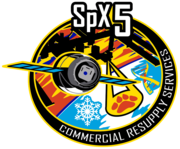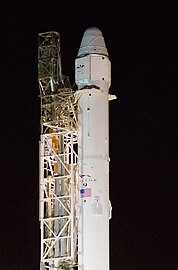SpaceX CRS-5
 CRS-5 Dragon on approach to the ISS | |
| Names | SpX-5 |
|---|---|
| Mission type | ISS resupply |
| Operator | SpaceX |
| COSPAR ID | 2015-001A |
| SATCATno. | 40370 |
| Mission duration | 31 days, 14 hours, 56 minutes |
| Spacecraft properties | |
| Spacecraft | Dragon 1 C107 |
| Spacecraft type | Dragon 1 |
| Manufacturer | SpaceX |
| Launch mass | 6,000 kg (13,000 lb) |
| Start of mission | |
| Launch date | 10 January 2015, 09:47:10UTC |
| Rocket | Falcon 9 v1.1(B1012) |
| Launch site | Cape Canaveral,SLC-40 |
| End of mission | |
| Disposal | Recovered |
| Landing date | 11 February 2015, 00:44 UTC[1] |
| Landing site | Atlantic Ocean |
| Orbital parameters | |
| Reference system | Geocentric orbit[2] |
| Regime | Low Earth orbit |
| Inclination | 51.65° |
| Berthing atISS | |
| Berthing port | Harmonynadir |
| RMScapture | 12 January 2015, 10:54 UTC[3] |
| Berthing date | 12 January 2015, 13:54 UTC[4] |
| Unberthing date | 10 February 2015, 17:11 UTC |
| RMS release | 10 February 2015, 19:10 UTC |
| Time berthed | 29 days, 3 hours, 17 minutes |
| Cargo | |
| Mass | 2,317 kg (5,108 lb)[5] |
| Pressurised | 1,823 kg (4,019 lb) |
| Unpressurised | 494 kg (1,089 lb) |
 NASA SpX-5 mission patch | |
SpaceX CRS-5,also known asSpX-5,was aCommercial Resupply Service missionto theInternational Space Station(ISS), conducted bySpaceXforNASA,and was launched on 10 January 2015 and ended on 11 February 2015. It was the seventh flight for SpaceX's uncrewedDragoncargo spacecraftand the fifth SpaceX operational mission contracted toNASAunder anISS resupply servicescontract.
Launch history
[edit]
By July 2014, the launch was scheduled by NASA for December 2014, with docking to the station projected to occur two days after launch.[6]Originally scheduled for a 16 December 2014 launch, the mission was changed to 19 December 2014, in order to give SpaceX more preparation time for a successful launch. The launch was postponed again to 6 January 2015, in order to allow more tests before committing to a firm launch date.[7][8]
On 6 January 2015, the launch attempt was placed on hold at 1 minute 21 seconds prior to scheduled lift-off after a member of the launch team noticedactuatordrift on one of twothrust vectorcontrol systems of the Falcon 9 second stage engine.[9]As this launch had an instantaneous launch window, meaning no delays are possible in the launch sequence, the flight was postponed to 9 January 2015.[9]On 7 January 2015, the flight was rescheduled for 10 January 2015.[10]
TheFalcon 9launch vehicle carrying the CRS-5 Dragon spacecraft successfully launched on 10 January 2015 at 09:47:10UTC.[11]Dragon reached the station on 12 January 2015. It was grappled by theMobile Servicing System(Canadarm2) at 10:54 UTC and berthed to theHarmonymodule at 13:56 UTC.[12]
Primary payload
[edit]The Dragon spacecraft for CRS-5 carried 2,317 kg (5,108 lb) of cargo to the ISS. Included in this was 490 kg (1,080 lb) of provisions and equipment for the crew, 717 kg (1,581 lb) of station hardware, 577 kg (1,272 lb) of science equipment and experiments, and the 494 kg (1,089 lb)Cloud Aerosol Transport System(CATS).[11]
CATS is aLIDARremote sensing instrument designed to measure the location, composition and distribution of pollution, dust, smoke, aerosols and other particulates in the atmosphere. CATS is to be installed on theKibō moduleexternal facility and is expected to run for at least six months, and up to three years.[13][14]
Upon completion of its stay, Dragon was loaded with 1,332 kg (2,937 lb) of outgoing cargo, returning it back toEarth.[5]
Post-launch flight test
[edit]In an unprecedented[15]test flight,SpaceXattempted to returnthefirst stageof the Falcon 9 through the atmosphere and land it on a 90 m × 50 m (300 ft × 160 ft)floating platformcalled theautonomous spaceport drone ship.[8]In October 2014, SpaceX had revealed that the ship was being built for SpaceX inLouisiana,[16]and by mid-December 2014, the ship was docked inJacksonville, Florida,ready to go to sea to support the test flight landing attempt.[17]
Results of first landing attempt
[edit]SpaceX attempted a landing on the drone ship on 10 January 2015. Many of thetestobjectives were achieved, including precision control of the first stage's descent to land on the platform at a specific point in the southAtlantic Oceanand a large amount of test data was obtained from the first use ofgrid fincontrol surfaces used for more precise reentry positioning. However, the first stage was destroyed due to ahard landing.[15]Musk said that one of the possible problems was the grid fins running out ofhydraulic fluid.[18]
The SpaceX webcast indicated that the boostback burn and re-entry burns for the descending first stage occurred, and that the descending then went "below the horizon", as expected, which eliminated the live telemetry signal. Shortly thereafter, SpaceX released information that the first stage did get to the drone spaceport ship as planned, but "landed hard... Ship itself is fine. Some of the support equipment on the deck will need to be replaced".[15][19][20][21][22]SpaceX made a video of the landing attempt available onVine.[23]
Gallery
[edit]See also
[edit]References
[edit]- ^Bergin, Chris (9 February 2015)."SpaceX CRS-5 Dragon returns home via Pacific splashdown".NASASpaceFlight.Retrieved28 March2015.
- ^"DRAGON CRS-5".N2YO.Retrieved25 January2015.
- ^"Dragon Arrives, Successfully Captured at Station".NASA. 12 January 2015.Retrieved12 January2015.
 This article incorporates text from this source, which is in thepublic domain.
This article incorporates text from this source, which is in thepublic domain.
- ^"Dragon Attached to Harmony Module".NASA. 12 January 2015.Retrieved12 January2015.
 This article incorporates text from this source, which is in thepublic domain.
This article incorporates text from this source, which is in thepublic domain.
- ^ab"Factsheet: SpaceX CRS-5"(PDF).NASA. December 2014.Retrieved31 May2021.
 This article incorporates text from this source, which is in thepublic domain.
This article incorporates text from this source, which is in thepublic domain.
- ^"Worldwide launch schedule".Spaceflight Now.Retrieved20 October2014.
- ^"NASA, SpaceX Update Launch of Resupply Mission to the Space Station".NASA. 11 December 2014.Retrieved12 December2014.
 This article incorporates text from this source, which is in thepublic domain.
This article incorporates text from this source, which is in thepublic domain.
- ^abBergin, Chris (17 December 2014)."SpaceX confirms CRS-5 launch slip to January 6".NASASpaceFlight.Retrieved18 December2014.
- ^abHarwood, William (6 January 2015)."SpaceX launch scrubbed by steering system problem".Spaceflight Now.Retrieved8 January2015.
- ^"Next SpaceX Launch Attempt Saturday, January 10".NASA. 7 January 2015.Retrieved8 January2015.
- ^abGraham, William (10 January 2015)."CRS-5 Dragon successfully launched – Core ASDS landing attempted".NASASpaceFlight.Retrieved15 January2015.
- ^Bergin, Chris (12 January 2015)."ISS berths SpaceX's Dragon following speedy arrival".NASASpaceFlight.Retrieved15 January2015.
- ^"Cloud-Aerosol Transport System (CATS)".NASA.Retrieved31 May2021.
 This article incorporates text from this source, which is in thepublic domain.
This article incorporates text from this source, which is in thepublic domain.
- ^"Cloud-Aerosol Transport System".NASA.Retrieved31 May2021.
 This article incorporates text from this source, which is in thepublic domain.
This article incorporates text from this source, which is in thepublic domain.
- ^abcClark, Stephen (10 January 2015)."Dragon successfully launched, rocket recovery demo crash lands".Spaceflight Now.Retrieved10 January2015.
- ^Foust, Jeff (25 October 2014)."Next Falcon 9 Launch Could See First-stage Platform Landing".SpaceNews. Archived fromthe originalon 25 October 2014.Retrieved25 October2014.
- ^Clark, Stephen (16 December 2014)."Photos: SpaceX's autonomous spaceport drone ship".Spaceflight Now.Retrieved16 December2014.
- ^Kramer, Miriam (12 January 2015)."SpaceX's Elon Musk Says Rocket Landing Test Ran Out of Hydraulic Fluid".SPACE.Retrieved20 January2015.
- ^Musk, Elon."Post-launch Twitter news releases".SpaceX.Retrieved10 January2015.
Rocket made it to drone spaceport ship, but landed hard. Close, but no cigar this time. Bodes well for the future tho.","Ship itself is fine. Some of the support equipment on the deck will need to be replaced","Didn't get good landing/impact video. Pitch dark and foggy. Will piece it together from telemetry and... actual pieces.
- ^Elon Musk [@elonmusk] (10 January 2015)."Rocket made it to drone spaceport ship, but landed hard. Close, but no cigar this time. Bodes well for the future tho"(Tweet) – viaTwitter.
- ^Elon Musk [@elonmusk] (10 January 2015)."Ship itself is fine. Some of the support equipment on the deck will need to be replaced..."(Tweet) – viaTwitter.
- ^Elon Musk [@elonmusk] (10 January 2015)."Didn't get good landing/impact video. Pitch dark and foggy. Will piece it together from telemetry and... actual pieces"(Tweet) – viaTwitter.
- ^"Close, but no cigar. This time".Vine. 16 January 2015.Retrieved17 January2015.







